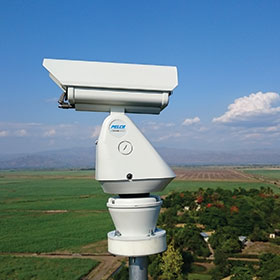

Forestry provides livelihood support to 652 000 people of South Africa’s rural population and the pulp and paper industry provides about 13 200 direct and 11 000 indirect employment opportunities. In terms of land use, the area under forestry is about 1.3 million hectares or approximately 1% of the total South African land area of 122.3 million hectares.
Trees generally take seven to 10 years to reach maturity, thereafter they are harvested. It is therefore important to ensure the protection of plantations which contribute approximately 1.4% to the country’s GDP. Not only do forest fires result in the loss of plantations, and therefore viable income and raw material, but there is secondary risk to the wildlife that coexists in forests and to the people working or living in the vicinity of plantations.

Recognising that lookout towers have limitations since they are manned by people who cannot possibly survey plantations without any breaks, early inroads into the development of an automated electronic surveillance system began in the 1990s. The end result was Firehawk, the first solution of its kind worldwide.
Willem Oosthuizen, operations manager for Alasia Marketing, explains that Firehawk is designed to provide early detection of fires, in order to minimise the damage they can cause. “We decided to develop a solution that would comprise off-the-shelf hardware elements. The PTZ CCTV cameras we sourced from Pelco are fit for purpose, providing high-resolution images. Easy to maintain and readily deployable in remote locations, the cameras have proven their worth in a number of installations in South Africa, Malawi, Ghana, Brazil and Chile.”

Due to the predominantly rural nature of the installations, with electricity supply being an issue, 90% of the Firehawk surveillance sites are solar power-based. The design of the system focuses on low power usage and low maintenance. Oosthuizen points out that the software and operational brains of the system are located offsite in smart control rooms.
The technology uses single camera positioning that provides directional alerts to the operational team in the case of an event. The HD cameras rotate 360° every 180 seconds, covering large areas at distances of up to 15 kilometres away, visibility permitting, in either panoramic view or individual sector analysis. The camera allows the operator to accurately pinpoint a specific sector to within less than 100 metres.
The system currently requires operator intervention in terms of deploying resources to identified locations, but Oosthuizen says that ultimately it will become a predominantly automated system. “It is important to note that not only does the system provide alerts on possible fire events, but it also provides access routes to allow teams to be safely and expeditiously deployed to site.”
When an alert is received in the control room, the operator verifies that it is for a legitimate event by determining whether the visual source is smoke. If a fire event is verified, he will then make contact with either the landowner or a fire protection association. When this decision-making process has concluded, the operator informs the system of the true source of the event, allowing the system to intelligently learn and thereby perform in the correct manner for future events.
While overseas clients prefer to use their own staff to man the systems, in South Africa the chosen route is a turnkey solution managed by the Firehawk team. As a result, the company offers control rooms as a service. It will provide an initial analysis of the site requirements in terms of how many cameras are required, the number of staff required for the control room and their subsequent employment and training, as well as the development of the physical control room. “This service means that the client is able to relax while we monitor his plantation and react to events, providing complete peace of mind,” says Oosthuizen.
For more information, contact Willem Oosthuizen, willem@alasia.co.za, www.alasia.co.za

© Technews Publishing (Pty) Ltd. | All Rights Reserved.